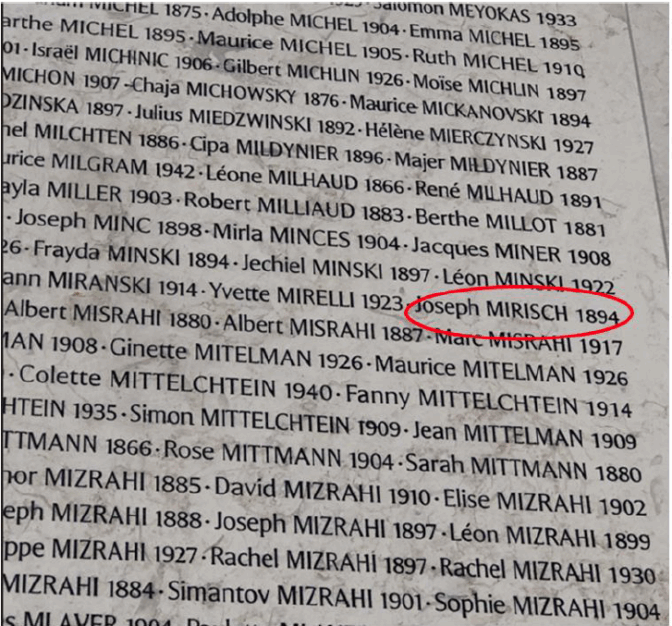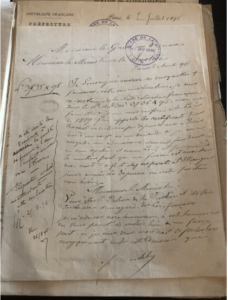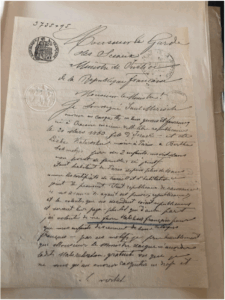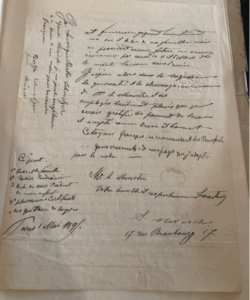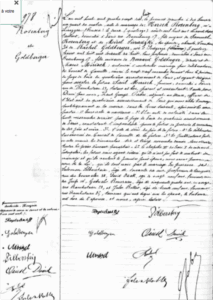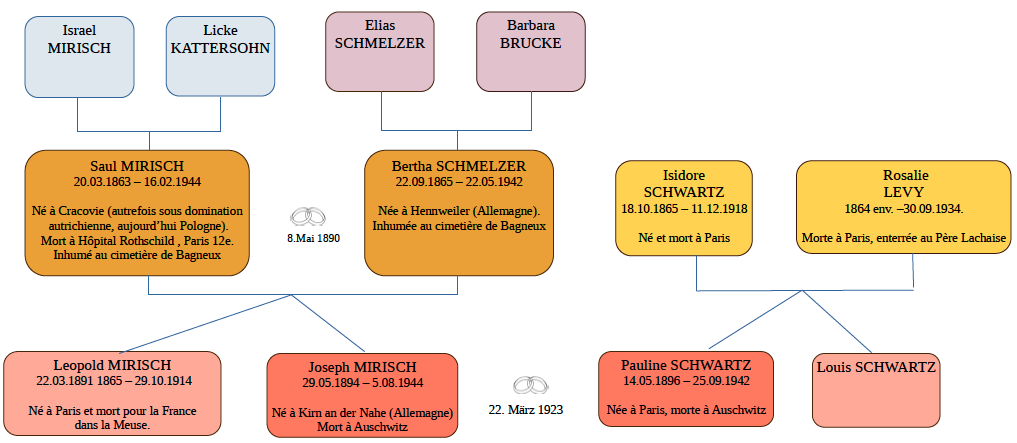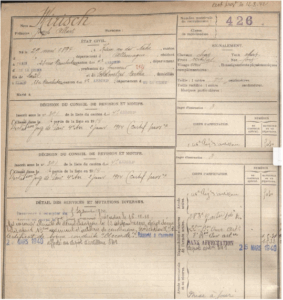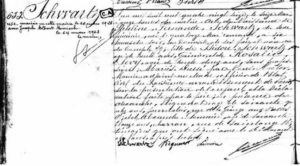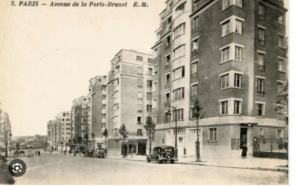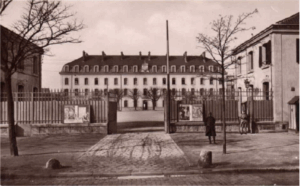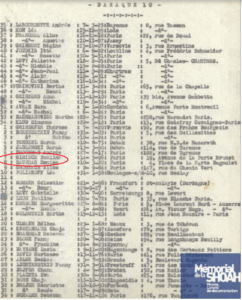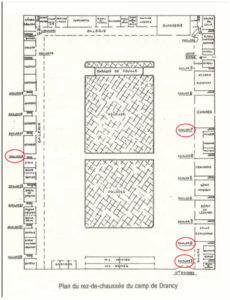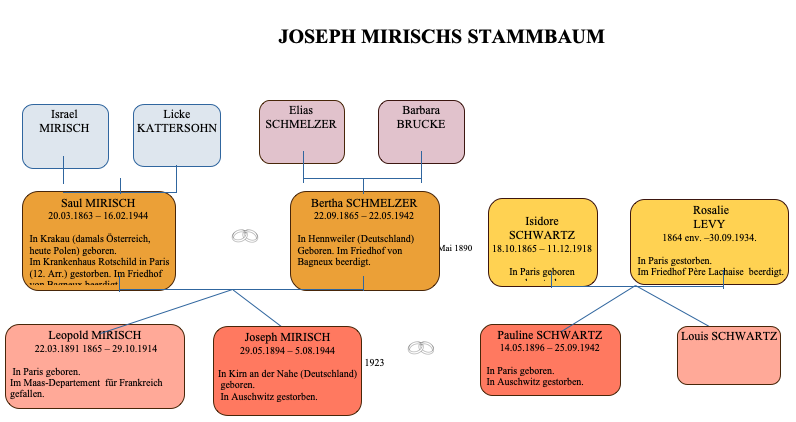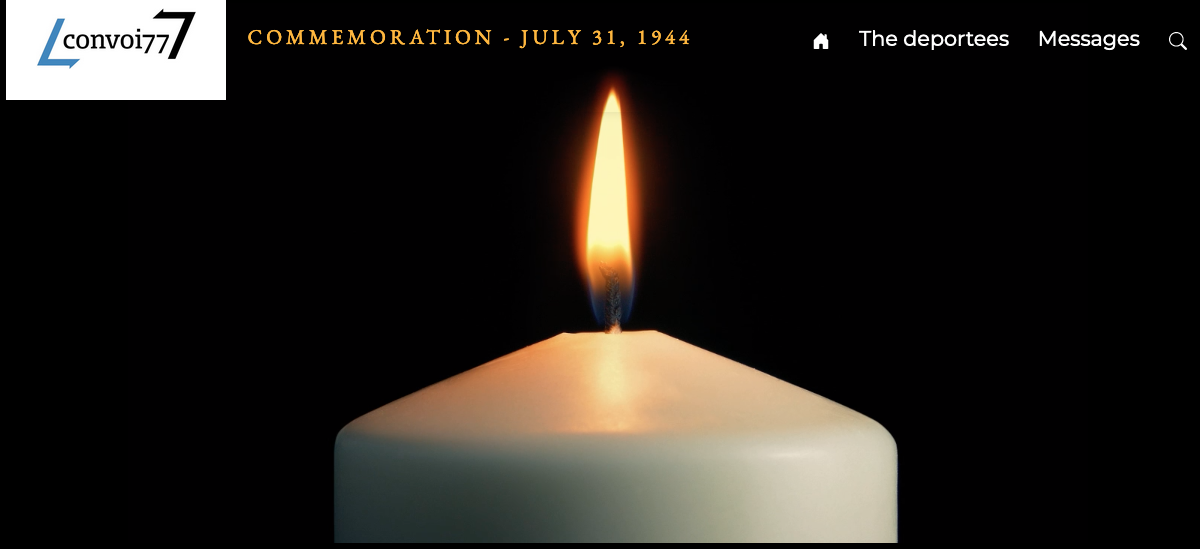Joseph MIRISCH
Joseph Mirisch was born on May 29, 1894 in Kirn an der Nahe in Germany. He died soon after he arrived in the Auschwitz-Birkenau killing center. His date of death was later declared to be August 5, 1944.
———————————————————————————————–
Für unsere deutschsprachigen Leser*innen: Der Text ist unterhalb der französischen Version auch auf deutsch verfügbar.
————————————————————————————————
I. Joseph’s parents
Joseph’s father, Saul Mirisch, was born on March 20, 1863 in Kraków, Poland (which was under Austrian rule at the time). His parents were Israël Mirisch and Liebe Kattersshon. He emigrated to France in 1883 and set up home at 24 rue Geoffroy L’Angevin in the 4th district of Paris. He worked as a furrier and cap-maker.
On May 8, 1890, he married Bertha Schmelzer, who was born on September 22, 1865 in Hennweiler in the Rhineland-Palatinate in Germany. She was living at 1 rue Fénelon in the 10th district of Paris, and worked as a cook. After the wedding, the couple moved in together at 17 rue Beaubourg, in the 4th district of Paris.

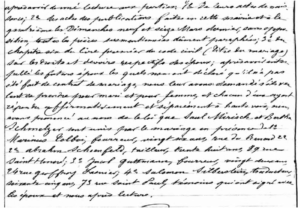
Saul Mirisch’s marriage certificate
© Victims of Contemporary Conflicts Archives Division of the French Ministry of Defense Historical Service, in Caen, Dossier n° 21P21P 481_222_40603
They went on to have two children. The first, Léopold, was born in the 4th district on March 22, 1891. By that time, they were living at 52 rue des Archives, also in the 4th district, but their official address was still listed as “Krakow (Austria)”. Two witnesses were present when the birth was registered, both of whom were furriers and one of whom lived at the same address as the couple.
Their second child, Joseph Albert Mirisch, was born in Germany on May 29, 1894. Bertha Schmelzer could not afford to give birth in France, as there was no national health system at the time (the French social security system only came into being in 1945), so she went back to her parents’ home in Kirn, Germany, to have the baby. Saul explained this in a letter he wrote when he applied to have the family naturalized as French citizens. He also made a point of saying that he had been born in the then Republican city of Krakow[1], and that he himself was a Republican.
Saul Mirisch made the aphttps://convoi77.org/deporte_bio/joseph-mirisch/#_ftn1plication for French nationality on May 1, 1895. He, his wife and Joseph were naturalized as French citizens on December 31, 1896. Léopold, because he was born in France, was entitled to French citizenship by declaration.
Saul Mirisch’s explanatory letter, from his naturalization application file © French national archives, ref. BB.34.411
Saul Mirisch’s application for French nationality, from his naturalization application file © French national archives, ref. BB.34.411.

Notification of granting of Franch nationality, from Saul Mirisch’s naturalization application file © French national archives, ref. BB.34.411
Saul had family in Paris. On November 1, 1898, he attended the wedding of Marie Mirisch’s daughter, Rachel Goldberber, who was still a minor at the time. As her ad hoc guardian, he was there to represent the family council, which had consented to her marriage to Hersh Rosenberg, who was born in Russia.
Rachel Goldberg’s marriage certificate
Although we know next to nothing about Saul’s religious convictions, we do know that his eldest son, Leopold, had his bar mitzvah at the temple on Rue Notre-Dame-de-Nazareth, in the 3rd district of Paris at the beginning of March 1904. We found no record of Joseph Albert’s bar mitzvah.
Arbre généalogique
Joseph and Pauline Mirisch’s family tree
II. Joseph Mirisch’s military service
Joseph had just turned 20 when Germany declared war on France in 1914, although had been in the army doing his military service since early January.
His military service record states that he was 5’10“, which was quite tall in those days, with brown eyes and hair. He had a “strong” nose.
On September 5, 1914, Joseph Mirisch was drafted into the 46th Artillery Regiment as a private to fight against Germany.
He was commended for his “courage” and “dedication” and awarded the French War Cross for having repaired the telephone network “under enemy fire” between August 16 and 20, 1917. On November 16, 1918, he was promoted to the rank of brigadier. He was demobilized in 1919 and issued with a “good behavior” certificate.
In 1940, at the age of 46, he was called up again to serve in the Second World War.
His brother Léopold, who was also a furrier, was less fortunate: mobilized on August 1, 1914, he fought in the 4th Infantry Regiment, and was reported missing on October 29, 1914 in Argonne in the Meuse department of France. He was later declared to have “Died for France”. His name is inscribed on the First World War memorial wall at the Père Lachaise cemetery in Paris.
Joseph Mirisch’s military service record, army number 426 © Paris archives
III. Marriage to Pauline Schwartz
Pauline Fernande Schwartz was born on May 14, 1896 at 79 Rue du Temple in the 3rd district of Paris. She was still living there when she got married in 1923. Her father, Isidore, had died on December 11, 1918, but her mother, Rosalie Levy[2], was still alive. Neither of the women were working at the time, and both lived at the same address as one of the witnesses, Louis Schwartz, who was a corset maker, as Isadore had been.
Pauline Schwartz’s birth certificate
Joseph and Pauline Mirisch set up home at 25 Rue Rambuteau, just a stone’s throw from Rue Geoffroy L’Angevin and equally close to Pauline’s apartment. Might they have met because they were relatively close neighbors?
An announcement was published in L’Univers Israélite (Jewish Universe) saying that Fernande and Albert (who both appear to have used their second names) were to be married at 2:45 p.m on March 23. at the synagogue on Rue Notre-Dame-de-Nazareth. This clearly demonstrates that although they were born in France, they had not forgotten their Jewish roots.
Joseph Mirisch and Pauline Schwartz’s marriage certificate,
Victims of Contemporary Conflicts Archives Division of the French Ministry of Defense Historical Service, in Caen, Dossier n° 21P481.222_40603
The couple then moved to 19 avenue de la Porte Brunet in the 19th district of Paris, which was a low-cost apartment building built in 1934.
Photo of Avenue la Porte Brunet ©Wikipedia
Although he had worked as a cap maker when he was younger, Joseph’s death certificate states that he was a travelling sales representative. That must have been before the Occupation, however, as Jews were then no longer allowed to move around freely.
Joseph Mirisch’s death certificate issued by the town hall of the 18th district of Paris
They do not appear to have had children of their own. However, as we shall see shortly, Pauline and her niece Denise, whose mother had died when she was under the age of two, were deported together.
IV. Arrest and deportation
Pauline was arrested on July 10, 1942, and taken to the Tourelles barracks at 133-161 Boulevard Mortier in the 20th district of Paris. The French authorities had converted the barracks into an in internment camp earlier in the Second World War. Between October 1940 and July 1941, it was used to hold Jews, stateless persons, and foreign refugees. From July 1941 onwards, French citizens were also imprisoned there, mainly women, as Drancy was a men-only camp until the Vel’ d’Hiv roundup, which took place on July 16-17, 1942[3].
Pauline was held in the Tourelles barracks for just over a month, until August 13, 1942, when she was transferred to Drancy camp in the north of Paris (now in the Seine-Saint-Denis department). Then, on September 1, she was moved to the Pithiviers camp in the Loiret department, where she stayed until September 21. She was assigned to barrack hut 10, along with her sister Suzanne’s daughter, Denise Alice Sauphar[4], who was born on March 10, 1920 in the 11th district of Paris. Pauline and Denise were deported on Convoy 35 to Auschwitz-Birkenau, where they were murdered in the gas chambers on September 25, 1942.
The Tourelles barracks ©Monpetit20e.com
Denise Sauphar’s birth certificate © Paris archives
Pauline Mirisch and Denise Saupharrs names on the list of prisoners in barrack hut 10 © Shoah Memorial, Paris
As for Joseph Mirisch, we found no further trace of him until July 8, 1944, when he was interned in Drancy. When he first arrived in the camp, he was carrying 326 francs, which the camp authorities confiscated, and was assigned prisoner number 24,964. He was initially put in a room on the 4th floor of building 18, then moved to the 4th floor of building 7, then the 4th floor of building 2, and lastly the 4th floor of building 1, which was the one closest to the camp exit and meant that he would soon be leaving for Auschwitz.
On July 31, 1944, he was deported on Convoy 77, the very last transport to leave Drancy. He arrived in Auschwitz during the night of August 3-4, and was sent straight to his death in the gas chambers. His official date of death was later declared to be August 5, 1944.
Joseph Mirisch’s receipt from Drancy camp © Shoah Memorial, Paris
Plan of the ground floor of Drancy camp © Serge Klarsfeld: The timeline of the persecution of Jews in France
Joseph Mirisch’s name is now inscribed on the Wall of Names at the Shoah Memorial in Paris, together with those of the 76,000 or so other Jews who were deported from France. This memorial reminds us of the men, women, and children who were dehumanized and murdered by the Nazis.
Joseph Mirisch’s name and birth year on the Wall of Names. Photo taken on January 22, 2025. © Shoah Memorial, Paris
We would like to thank Ms. Podetti for sending us records and helping us with our research, and Ms. Klejman for proofreading our work and providing additional details.
Notes & references
[1] This refers to Congress Poland, a semi-autonomous city-state republic founded in 1815 during the Congress of Vienna. It was based on the Napoleonic Code and serfdom was abolished, but in reality it was little more than a Russian puppet state. In 1946, following an uprising, Austria regained control of it. The Polish people saw this as a symbol of freedom and republican values, as did Saul Mirish, who believed that such a background would add credibility to his naturalization application.
[2] Isidore Schwartz, who lived at 39 Rue de Belleyme in Paris and whose parents were Noé and Célestine Hirsch, and Rosalie Levy published their marriage banns on October 5, 1890, at the town hall of the 3rd district of Paris. On July 18, 1921, Anna Suzanne, wife of Henri Sauphar and Pauline’s older sister, died in the 10th district.
[3] In fact, right from the start, people that the Vichy regime termed “undesirables” were also there, as Johanna Lehr explains in her latest book Au nom de la Loi. La persécution quotidienne des Juifs à Paris sous l’Occupation (In the name of the law. The daily persecution of Jews in Paris during the Occupation), published by Gallimard, 2024
[4] Her father, Henri, lived at 19 Avenue de la Porte Brunet when he died on October 6, 1969. Source: file on Denise Sauphar Victims of Contemporary Conflicts Archives Division of the French Ministry of Defense Historical Service, in Caen, dossier 21 P 536 023
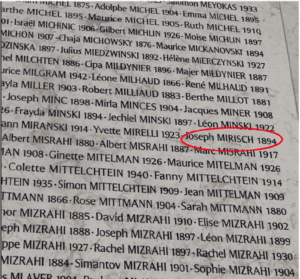 Joseph MIRISCH
Joseph MIRISCH
Joseph Mirisch wurde am 29. Mai 1894 in Kirn an der Nahe in Deutschland geboren. Er starb im August 1944 im Konzentrationslager Auschwitz-Birkenau.
I. Seine Eltern
Sein Vater Saul Mirisch wurde am 20. März 1863 in Krakau geboren. Er war der Sohn von Israel Mirisch und Licke Kattersohn. Heute ist Krakau eine polnische Stadt aber zu dieser Zeit gehörte sie Österreich. Er emigrierte 1883 nach Frankreich und ließ sich in Paris, in der Rue Geoffroy L’Angevin Nr 24 im 4. Arrondissement nieder, das heißt im Viertel Namens Le Marais, wo die aus dem Osten emigrierten Juden lebten. Von Beruf war er wie viele anderen in diesem Viertel Pelzhändler und Kappenhersteller.
Am 8. Mai 1890 heiratete er Bertha Schmelzer, eine Deutsche, die am 22. September 1865 in Hennweiler im Rheinland-Pfalz geboren wurde. Sie war Köchin und wohnte damals Rue Fénelon Nr 1 im 10. Arrondissement von Paris. Das Paar zog dann in die Rue Beaubourg Nr17.
Saul und Bertha bekamen zwei Kinder: Leopold am 22. März 1891 im 4. Arrondissement geboren und Joseph, am 29. Mai 1894 geboren. Als Leopold geboren wurde, wohnte das Ehepaar in der Rue des Archives Nr 52 aber ihre offizielle Adresse war immer noch in Krakau. Zwei Pelzhändler, unter denen einer an der selben Adresse wohnte, waren bei der Geburt dabei, was uns ahnen lässt, dass auch Saul in diesem Beruf tätig war.
Was Joseph betrifft, wissen wir, dass er in Deutschland geboren wurde. Da Bertha und Saul bescheiden waren, konnte Bertha ihr Kind nicht in Frankreich auf die Welt bringen: Die Sozialversicherung gab es noch nicht in Frankreich (erst ab 1945). Deshalb fuhr sie zu ihren Eltern nach Kirn in Deutschland, um zu gebären, wie es Saul in einem Brief erklärt, um die französische Staatsbürgerschaft für seine Familie zu erreichen. In diesem Brief bestand er darauf, dass er in einer Stadt (Krakau) geboren wurde, die damals republikanisch war und dass er selbst ein überzeugter Republikaner war.
Saul Mirisch reichte am 1. Mai 1895 einen Einbürgerungsantrag ein und bekam sowie Joseph und seine Frau am 31. Dezember 1896 die französische Bürgerschaft. Leopold, der in Frankreich geboren wurde, war automatisch Franzose.
Saul hatte Verwandten in Paris und vertrat den Familienrat. Dieser genehmigte die Heirat von Rachel Godberger (Tochter von Marie Mirisch, damals minderjährig) mit Hersch Rosenberg (in Russland geboren), die am 1. November 1898 stattfand.
Wir wissen nur weniges über Sauls Überzeugungen und Glauben aber wir wissen, dass sein ältester Sohn Leopold seine Bar-Mitsvah Anfang März 1904 im Tempel der Rue Notre-Dame de Nazareth im 3. Arrondissement gefeiert hat.
II. Joseph Mirischs militärisches Engagement
Joseph besuchte bestimmt die Schule im Viertel Le Marais. In seiner militärischen Akte steht, dass er das 3. Bildungsniveau hatte, also hatte er wahrscheinlich das Abschlusszeugnis erhalten.
So wurde er beschrieben: er war 1,79 m groß, was sehr groß zu dieser Zeit war, er hatte braune Augen und Haare und eine dicke Nase.
Er war kaum 20 Jahre alt, als Deutschland Frankreich den Krieg erklärte aber seit Anfang Januar machte er seinen Militärdienst. Am 5. September 1914 trat Joseph Mirisch als Soldat in das 46. Artillerie-Regiment ein, um gegen Deutschland zu kämpfen.
Vom 16. bis zum 20. August 1917 zeichnete er sich durch seinen Mut und seine Aufopferung aus, indem er Telefonverbindungen unter feindlichem Beschuss reparierte. Dafür bekam er das Ehrenkreuz.
Am 16. November 1918 wurde er Gefreite und 1919 demobilisiert. Er bekam ein Führungszeugnis.
Sein Bruder Leopold, der auch Pelzhändler war, hat weniger Glück gehabt: er wurde am 1. August 1914 im 4. Infanterieregiment mobilisiert, dann am 29. Oktober in Argonne in der Meuse als Vermisster und später als „Für Frankreich gestorben“ erklärt. Man kann seinen Namen auf das Monument der während des Ersten Weltkrieges gestorbenen Pariser, im Friedhof Père Lachaise lesen.
Als der Zweite Weltkrieg ausbrach, wurde Joseph Mirisch mit 46 bis zum 5.08.1940 mobilisiert.
III. Ehe mit Pauline Schwartz
Pauline Fernande Schwartz wurde am 14. Mai 1896 im 3. Arrondissement von Paris geboren. Bis März 1923, Jahr ihrer Hochzeit mit Joseph, wohnte sie mit ihrer Mutter Rosalie Levy in der Rue du Temple Nr 79 im 3. Arrondissement, wo sie geboren wurde. Ihr Vater Isidore starb am 11.Dezember 1918. Da sie keinen Beruf ausübten, wohnten sie bei Louis Schwartz, der Trauzeuge und Hüfthalterfabrikant wie Isidore war.
Die Familie Mirisch hatte sich in der Rue Rambuteau Nr 25 niedergelassen, nicht weit von der Rue Geoffroy L’Angevin und auch nicht weit von Paulines Wohnung? Haben sie sich als Nachbarn kennengelernt?
Die Zeitung L’univers israélite kündigte die Heirat von Fernande (wahrscheinlich verwendete sie diesen Vornamen) mit Joseph am 23. Mârz 1923 um 14:45 Uhr in der Synagoge der Rue Notre-Dame de Nazareth. Es zeigt, dass sie die jüdischen Traditionen nicht vergessen hatten.
Nach der Hochzeit ließ sich da Ehepaar in der Rue de la Porte Brunet Nr19 im 19. Arrondissement nieder. Sie liegt im amerikanischen Viertel, nicht weit von der Butte au Chapeau Rouge, wo es viele im Jahre 1934 gebauten Sozialwohnungen gab.
In seiner Jugend war Joseph Kappenhersteller aber seine Sterbeurkunde deutet darauf hin, dass er Handelsvertreter war – selbstverständig vor der Besatzung von Frankreich, da es den Juden verboten war zu reisen.
Es scheint, dass das Ehepaar keine Kinder hatte. Dennoch wie wir es später sehen werden, wurden Pauline und ihre Nichte Denise, deren Mutter gestorben ist, als sie kaum 2 Jahre alt war, zusammen deportiert. Haben Joseph und Pauline das Kind empfangen, dessen Vater wieder verheiratet war?
IV. Die Verhaftungen und die Deportation
Am 10. Juli 1942 wurde Josephs Frau Pauline verhaftet und in der Kaserne „Les Tourelles“ in Paris, Boulevard Mortier Nr 133-161 im 20. Arrondissement von Paris interniert. Diese Kaserne ist während des Zweiten Weltkrieges ein Internierungslager auf Entscheidung der französischen Behörde geworden. Dort wurden zwischen Oktober 1940 und Juli 1941 Juden, Staatenlose und ausländische Flüchtlinge interniert aber auch Franzosen, die sogenannten „Unerwünschten“ von Vichy wie es Johanna Lehr in ihrem Buch Im Namen des Gesetzes zeigt.
Pauline blieb einen Monat lang in der Kaserne und am 13. August 1942 führte man sie ins Lager von Drancy (Seine-Saint-Denis). Von da aus wurde sie am 1. September 1942 nach Pithiviers, wo sie bis zum 21. September 1942 blieb. Dort war Pauline mit derTochter ihrer verstorbenen Schwester Susanne, Denise Alice Sauphar, geb. am 10 März 1920 im 11. Arrondissement. Schließlich wurden beide am 21. September 1942 nach Auschwitz-Birkenau mit dem „Convoi 35“ deportiert, wo sie am 25. September 1942 in den Gaskammern ermordert wurden.
Man weiß nicht, wo Joseph Mirisch zwischen 1942 und 1944 war. Man findet seine Spur wieder, erst 1944, als er am 8. Juli im Internierungslager von Drancy interniert wurde. Er hatte 326 Francs bei sich, die ihm die Behörden des Lagers beschlagnahmten. Seine Häftlingsnummer war : 24964.
Als er in drancy ankam, war er zuerst im 4. Stock des Gebäudes Nr 18, dann im Stock des Gebäudes Nr 7, dann im 4.Stock des Gebäudes Nr 2 und schließlich im Gebäude Nr 1, immer im 4. Stock. Dieses Gebäude war das nächste vom Ausgang des Lagers. Dies bedeutete eine baldige abfahrt nach Auschwitz.
Er wurde nach Auschwitz-Birkenau deportiert und zwar am 31. Juli 1944 mit dem „Convoi 77“, der der letzte Konvoi war. Er kam in der Nacht vom 3. August 1944 im Konzentrationslager Auschwitz-Birkenau an und starb dort wenige Tage später in den Gaskammern. Das offizielle Todesdatum ist der 5.August 1944.


 Français
Français Polski
Polski